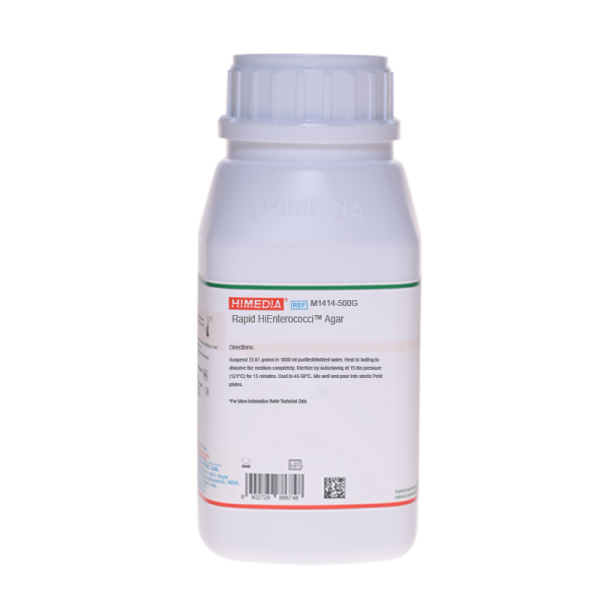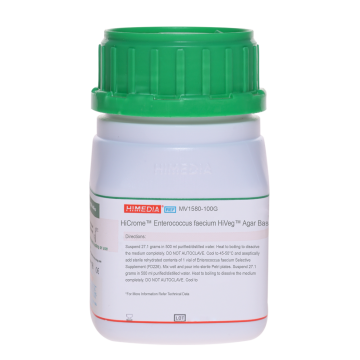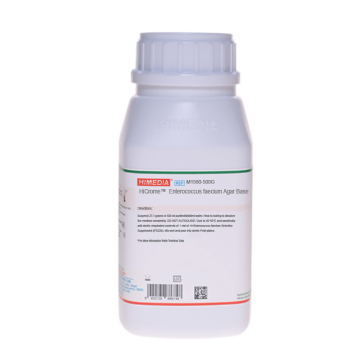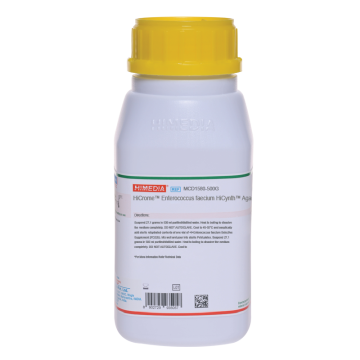 Your enquiry has been submitted
Your enquiry has been submitted
Rapid Hi-Enterococci Agar
Presumptive Confirmed Test#CC293D
Intended use
Recommended for rapid and easy identification and differentiation of Enterococci from water samples.
Composition
| Ingredients | g/L |
|---|---|
| Peptone, special | 10.000 |
| Sodium chloride | 5.000 |
| Sodium azide | 0.300 |
| Chromogenic mixture | 0.060 |
| Polysorbate 80 (Tween 80) | 2.000 |
| Disodium hydrogen phosphate | 1.250 |
| Agar | 15.000 |
Final pH (at 25°C): 7.5±0.2
**Formula adjusted, standardized to suit performance parameters
Directions
Suspend 33.61 gram in 1000 ml purified/distilled water. Heat to boiling to dissolve the medium completely. Sterilize by autoclaving at 15 lbs pressure (121°C) for 15 minutes. Cool to 45-50°C. Mix well and pour into sterile Petri plates.
Principle And Interpretation
Enterococci are commonly found in the faeces of humans and other warm-blooded animals. Although some strains are ubiquitous and not related to faecal pollution, the presence of Enterococci in water is an indication of faecal pollution and the possible presence of enteric pathogens. The Enterococci test is recommended as a measure of ambient fresh and marine recreational water quality. Epidemiological studies have lead to the development of criteria which can be used to promulgate recreational water standards based on established relationships between health effects and water quality. The significance of finding Enterococci in recreational fresh or marine water samples is the direct relationship between the density of Enterococci and the risk of gastrointestinal illness associated with swimming in water (1,2). The Rapid HiEnterococci™ Agar allows for rapid identification and differentiation of Enterococci from water samples. The peptone special supplies nitrogenous, carbonaceous compounds, long chain amino cids, vitamins and other essential nutrients. sodium chloride provides the osmotic balance for rapid growth of Enterococci. Sodium azide inhibits the accompanying microflora, especially the gram-negative organisms. The enzyme ß-D-glucosidase present in Enterococci cleaves the chromogenic substrate, resulting in a blue green colour of the colonies.
Type of specimen
Water samples
Specimen Collection and Handling:
For water samples, follow appropriate techniques for sample collection, processing as per guidelines and local standards (3). After use, contaminated materials must be sterilized by autoclaving before discarding.
Warning and Precautions :
Read the label before opening the container. Wear protective gloves/protective clothing/eye protection/ face protection. Follow good microbiological lab practices while handling specimens and culture. Standard precautions as per established guidelines should be followed while handling specimens. Safety guidelines may be referred in individual safety data sheets
Limitations
- Some species may show poor growth due to nutritional variations.
- Slight colour variation may be observed depending upon the utilization of the substrate by the organism.
- Further biochemical and serological test are need to be carried out for confirmation.
Performance and Evaluation
Performance of the medium is expected when used as per the direction on the label within the expiry period when stored at recommended temperature.
Quality Control
Appearance Cream to yellow homogeneous free flowing powder
Gelling Firm, comparable with 1.5% Agar gel
Colour and Clarity of prepared medium Light amber coloured, clear to slightly opalescent gel forms in Petri plates
Reaction Reaction of 3.36% w/v aqueous solution at 25°C. pH: 7.5±0.2
pH 7.30-7.70
Cultural Response Cultural characteristics observed after an incubation at 35-37°C for 18-24 hours
| Organism | Inoculum (CFU) | Growth | Recovery | Colour of Colony |
|---|---|---|---|---|
| Escherichia coli ATCC 25922 (00013*) | 50-100 | none to poor | <=10% | |
| Enterococcus faecalis ATCC 29212 (00087*) | 50-100 | good | 40-50% | blue green |
| Pseudomonas aeruginosa ATCC 27853 (00025*) | 50-100 | none to poor | <=10% | |
| Staphylococcus aureus subsp. aureus ATCC 25923 (00034*) | 50-100 | good | 40-50% | colourless |
Key: (*) Corresponding WDCM numbers.
Storage and Shelf Life
Store between 15-25°C in a tightly closed container and the prepared medium at 2-8°C. Use before expiry date on the label. On opening, product should be properly stored dry, after tightly capping the bottle in order to prevent lump formation due to the hygroscopic nature of the product. Improper storage of the product may lead to lump formation. Store in dry ventilated area protected from extremes of temperature and sources of ignition Seal the container tightly after use. Product performance is best if used within stated expiry period.
Disposal
User must ensure safe disposal by autoclaving and/or incineration of used or unusable preparations of this product. Follow established laboratory procedures in disposing of infectious materials and material that comes into contact with sample must be decontaminated and disposed of in accordance with current laboratory techniques (4,5).
Reference
- Litsky W., Mallmann W. L., a Fifield C. W., 1953, Am. J. Pbl. Hlth., 43:873.
- Manafi M., Sommer R., 1993, Wat. Sci. Tech. 27:271-274.
- Lipps WC, Braun-Howland EB, Baxter TE, eds. Standard methods for the Examination of Water and Wastewater, 24th ed. Washington DC:APHA Press; 2023.
- Isenberg, H.D. Clinical Microbiology Procedures Handbook 2nd Edition.
- Jorgensen, J.H., Pfaller, M.A., Carroll, K.C., Funke, G., Landry, M.L., Richter, S.S and Warnock., D.W. (2015) Manual of Clinical Microbiology, 11th Edition. Vol. 1.Clinic
| Product Name | Rapid Hi-Enterococci Agar |
|---|---|
| SKU | M1414 |
| Product Type | Regular |
| Physical Form | Powder |
| Origin | Animal |
| Packaging type | HDPE |
| References | 1.Baird R.B., Eaton A.D., and Rice E.W., (Eds.), 2015, Standard Methods for the Examination of Water and Wastewater, 23rd ed., APHA, Washington, D.C. |
| Customized Product Available | No |







